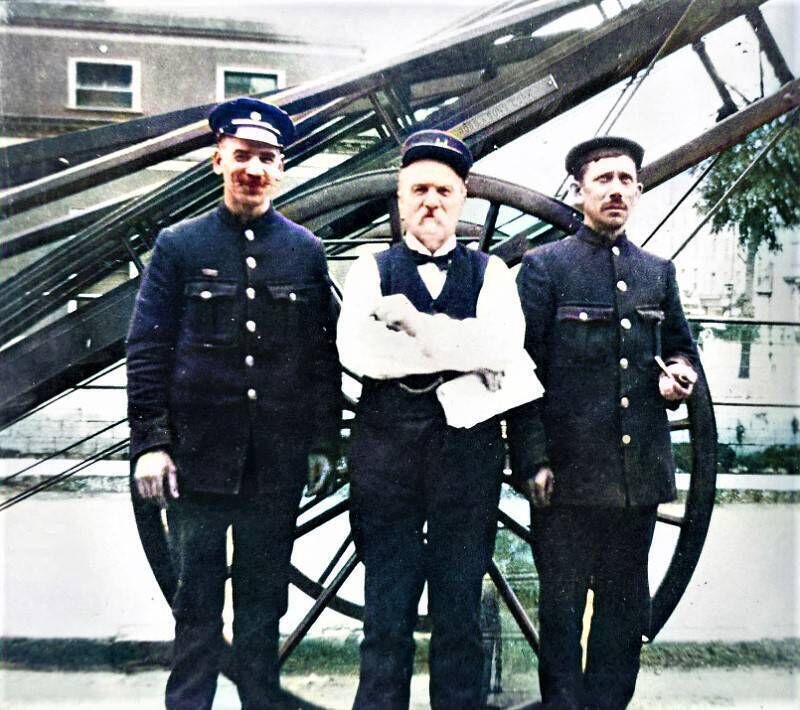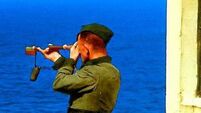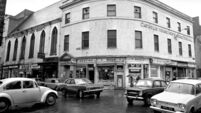Corkman who was saved from death... by a tombstone!

Buckingham Place in Cork city today - the white building is where the tenements stood in 1903.
WHY on earth John Moynihan’s mother bought him a tombstone has been lost in the mists of time - but his decision to then store it in the bedroom of his house in Cork city - bizarrely - saved his life.
The odd transaction took place 121 years ago, and John kept the tombstone in the apartment where he was living, on the first floor of a three-storey building on Buckingham Place on the city’s southside.
Shortly after 7am on Thursday, March 5, 1903, the apartment block collapsed, killing two people. Miraculously, John was not among them.
As the masonry collapsed around him and all the floors gave way, John was lying on the tombstone, and that, as well as a bed that fell on him, cushioned him from serious injury. He was trapped in the rubble for two hours before being saved.
Sadly, the same could not be said for two of his fellow residents.
******
The Chinese call it the ‘smiling death’, a condition that strikes the ‘survivors’ of disasters who are effectively dead, even as they are thanking their rescuers for saving them. In the west, it is known as rhabdomyolysis - crush syndrome - a complex affliction that causes kidney failure when pressure on damaged muscles is released.
After the apartment collapse that morning in 1903, poor 80-year old Ellen Donovan was buried up to her neck in debris; all that could be seen of her above the layers of crushed masonry, brick and timber was her head.
After much painstaking cutting, digging and probing by Cork Fire Brigade, 25-year-old fireman Martin Higgins, whose lithe frame was ideal for such a mission, had managed to reach her. She asked him to fetch the priest and, gingerly, Fr Barrett, of the nearby South Chapel, squirmed through the 18-inch-square makeshift tunnel to where she lay.

He administered the Last Rites and pressed her to take some brandy he had brought. She refused, saying she had taken the pledge from Father Mathew and would not break it.
Next to crawl through the catacomb of rubble to the trapped woman was Dr E.V. Cantillon, the house surgeon at the South Infirmary. The brandy might have revived her, he said later, but she would not have recovered.
Rescuers spent another hour patiently widening the hole around the distressed woman, acutely conscious that even a slight after-shock might send what remained standing of the groaning structure tumbling down on top of them.
Eventually, they managed to set Ellen Donovan free.
And then, quietly, she expired.
******
Nos 2 and 3, Buckingham Place, were four-storey tenements in 1903, each with a garret and basement, which stood just around the corner from White Street, on George’s Quay.
A stone tablet, found in the ruins, indicated they had been built in either 1736 or 1756 - the Cork Examiner reporter was unable to read the third digit clearly. The Independent said they were probably the oldest houses in Cork
The block was owned by an absentee landlady who lived in England. Her affairs were managed by her local agent, Mr Hawkes. The two houses brought in rent of £32 and £36 a year respectively.
In 1903, nine families lived between the two houses; a total of more than 60 people.
There had been constant complaints to the agent about the state of the houses. Parts of the roofs were missing, and people could see daylight through the walls. One tenant recalled that “a car (i.e., a horse and dray), on passing in front of the house, would shake it all over”.
In early March, 1903, a severe storm hit, which several of the occupants noted “shook the place considerably”.
Notwithstanding that, City Engineer Mr H. A. Cutler said he had never received any report on the condition of the houses.
******
That Thursday morning, the houses collapsed with a thunderous roar, sending a great cloud of debris-dust into the air.
The noise was heard in the nearby Central Fire Station on Sullivan’s Quay and at the Royal Irish Constabulary Headquarters on Union Quay, alerting rescue services immediately.
As the three storeys crumbled, concrete and stone snapped like brittle twigs. Age-old roofs, chimney stacks, rafters, joists, flooring, furniture, fireplaces and detritus of every description ended up heaped in a giant stack of rubble.
To this instant disaster zone was added another menace: Fire.
Some dutiful husbands had, before going out to work, lit fires in their grates, the lighted coals of which now spilled out and set fire to the surrounding timber.
As the dust settled on the neighbourhood, a great silence momentarily descended. Then, from within the ruins, screams of terror and pain pierced the air.
The fire brigade, under the legendary Captain Hutson, and police from Union Quay, under Head Constable Kirby, arrived almost simultaneously. The fires were at once tackled with ‘chemical fire engines’ (large fire extinguishers on wheels).

For the next three hours, assisted by an army of volunteers, and using the rudimentary tools at their disposal - hammers, crowbars, axes, chisels and such like - the brigade and police managed to extricate some of the trapped.
At a time when ‘frontline services’ received no special training in disaster rescue management and extrication, the teams had to rely entirely on their wits, common sense, and past experience to get them through the morning.
Every physical resource, every shred of emotional toughness and human ingenuity, was put to the ultimate challenge.
Some residents, on hearing the first rumbling of the impending disaster, had grabbed their children and run into the street in their night attire, but dozens were not so lucky. Many were carried, still in their beds, as the floors collapsed, down to the basement where, terrified, shocked, and coiled in fear, they awaited rescue.
A mountain of crushed debris, sprouting shards of flesh-ripping glass and jagged iron, covered them.
Miraculously, there were only two fatalities; the elderly Mrs Donovan, whose son had only left the building to go to work seconds before the collapse, and a little boy, John Donovan, who died of “shock” before the rescuers could get to him.
His father, also John Donovan, said the family had only moved there three weeks earlier. He had been in bed on the second floor when the building collapsed, sending him and his two children to the basement. The other child survived.
Mr Donovan told the inquest he noticed a crack in the wall the night before with rain coming in, and he had moved the bed away from the water.
******
The landlady’s agent tried to shift responsibility for the tragedy onto the fire brigade. In his evidence to the inquest, he admitted he had received complaints on the state of the premises from time to time, and “some of the roof was not intact”, but “generally speaking” the issues were dealt with. However, on a previous occasion, the brigade had “gone to a fire which was in the flue, and broken into the dividing wall”, and he blamed that for the fall of the structure.
Neither City Engineer nor Coroner gave any weight to his assertion, the Examiner recording “there can be no doubt that the accident was the result of old age” (of the buildings). The inquest heard the ‘party wall’ - a dividing partition between the two buildings - collapsed, leading to the whole house of cards tumbling.
A number of brigade men were singled out by the Coroner for special mention for their efforts, along with Capt Hutson: Firemen McCarthy, Barry, Higgins, Reardon, Ahern, O’Leary, and Ring.
Head Constable Kirby, with Constables McBride and O’Brien, “performed Trojan work”, as did civilians Maurice Walsh, Cornelius Kelleher, J. Dunnecliffe, J. O’Connell, and Daniel Gloyn, son of Fireman Gloyn.
Pat Poland is the author of Cork City Firefighters: A Proud Record. A Visual History From 1950.







